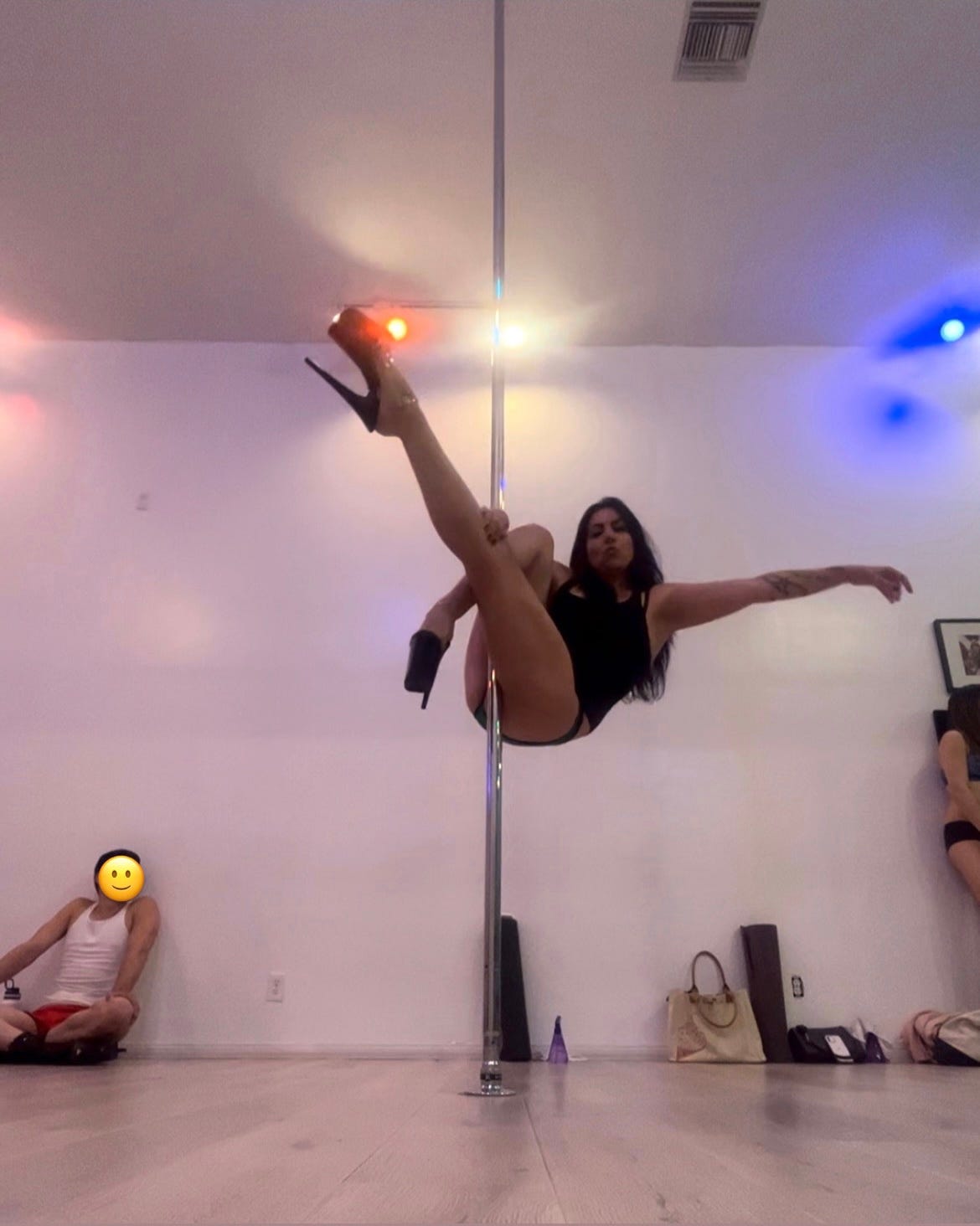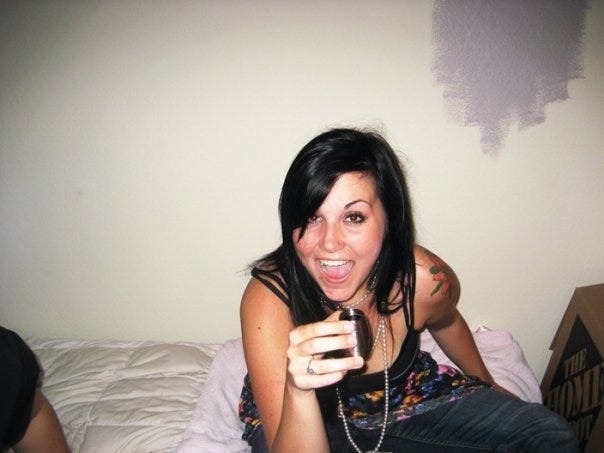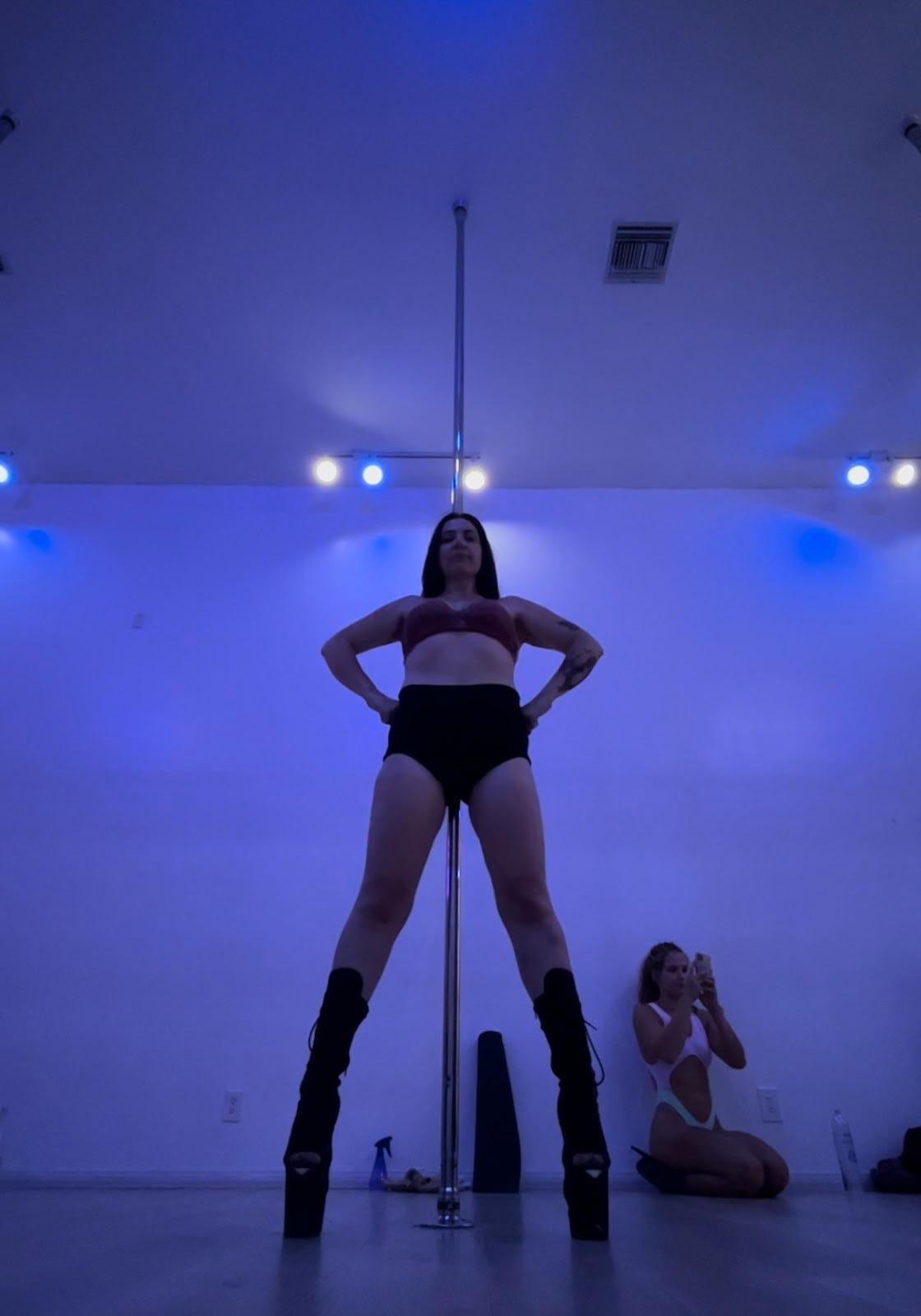Divorce, Disorder, Drinking, and Dancing on a Pole
The true revenge body is the one that makes you feel most alive
We were sitting in my car with the windows up in the Starbucks parking lot on a hot May morning when I told my husband I wanted a divorce. I was grateful that my tears of relief blended in with the rest of the sweat on my face. I wasn’t surprised by his lack of reaction; a part of me wondered if he was just as relieved as I was that this trainwreck of a marriage was ending.
I married this man at 22 as a result of my family’s conservative Christian sexual ethics, which restricted us from cohabitation until after the wedding. Within six months of moving in - after the paperwork was signed and that expensive night was over - I knew I made a huge mistake.
I had been a confident jazz and hip-hop dancer before my marriage, deeply connected to my body despite my conservative culture’s attempts to shame me for it. But I stopped dancing after the wedding. Over the seven years that followed, my husband grew distant and unfaithful, and I ate food and drank alcohol to cope. I fell into a spiral of eating and drinking and then believing I was unworthy of love and attention, resulting in more eating and drinking and self-loathing.
My husband only reinforced it all, putting the blame for his neglect and cheating squarely on my already overly burdened shoulders. I was fully conscious of the unhealthy way my mind and body were changing, yet I had been told that divorce wasn’t an option for me. I felt as if I had disappeared. Resigned and trapped, I continued to disconnect from my body, and I continued to drink. There was nothing else I believed I could do.
Six years into our marriage, a personal health crisis shook me out of my trance and started preparing me for a different life—one I knew, somewhere in my gut, that I deserved. In pop culture, the (very misguided) concept of the revenge body was just getting legs, so I figured I’d start there. Although I kept drinking, I decided to focus my efforts on minimizing my food calories. I planned a new diet and exercise regime as I plotted my exit. I quietly worked on my plan to escape the marriage, telling no one but my closest friends.
From the outside, it simply looked like I was trying to get healthy - but the more reinforcements I got for my efforts, the faster my obsession to see the scale move set in. Anti-fat bias was not yet a major cultural discussion, and the trauma from my marriage put up major blinders to the unhealthy attitude about body size that I adopted. Furthermore, my soon-to-be ex-husband’s renewed interest in me (or maybe just my new body?) was too little and too late. It only solidified my resolve.
After that discussion in the Starbucks parking lot, almost everyone in my life except my few closest friends iced me out because of their disappointment with my decision to initiate divorce. I could also tell that they had quickly developed a half-true understanding of why I had started losing weight throughout the previous two years (preparing my newly single revenge body.) Some felt hurt I hadn’t talked to them about it while I was plotting my exit, even though I knew they wouldn’t have been supportive; some thought I was being selfish; far too many worried more about my ex’s well-being after the divorce than mine.
My weight loss went into turbo drive as I focused on my new life rather than responding to the fallout all around me, and I quickly notched several numbers down on the measuring tape. I bought a new wardrobe in a different section of the store. Outside of my circle of loved ones, which had quickly collapsed in on me, I started debuting my smaller self to new friend groups and social scenes that were heavily influenced by alcohol. My confidence, and drinking, began to skyrocket. For the first time in a decade, I finally didn’t feel invisible.
But the visibility came at a cost. I started to believe that my worthiness only depended on those moments of outside validation. I started craving superficial attention; I amped up the drinking, partying, and calorie restriction even further. I began weighing myself three to five times a day to meet my goal, which consistently sunk lower and lower on the (white supremacist and fatphobic) BMI chart.
With her own divine wisdom of the violence of this patriarchal standard, my body desperately tried to intervene - she spouted soft hair all over to keep me warm, slowed my digestion, and prioritized my metabolism over everything else, which led to my hair thinning and the unnerving phenomenon of the pads of my hands going completely flat. After eight months, I ended up 100 pounds lighter than I was the moment I set my plan for a new life into action. Revenge body, accomplished. Or so I thought.

A few loved ones put their disappointment in my choice to divorce aside and intervened. They convinced me to enter a sixteen-week rehabilitation program, where I had to restore my weight, eat under supervision, and go through hours of individual and group therapy. Within the safety of my team’s support, I slowly learned that my eating disorder took hold in response to a few things: first, it was a result of years of trauma married to a man who made sure I knew how little he thought of me. Second, it was a coping mechanism for my body shame, also a result of Christian purity codes and diet culture. And third, with no one to guide me as I exited my marriage, I had to figure out my worth all on my own in a society that ties a woman’s worth almost exclusively to her “beauty,” as well as her productive and submissive role in a heteronormative nuclear family.
But more than anything, I had been spiraling from feeling like there was nothing in my life that I was allowed to control for thirty years. With so much shame heaped on me after I left my marriage, food intake seemed to be the only thing I had any agency over. And as I began to deconstruct the false beliefs about my appearance and worthiness that led me to treatment, I carefully re-introduced myself to my body, learning what she needed for love and nourishment. And I vowed to help burn the whole patriarchal system to the ground which led me to believe I was only worth what my body could do for it.
I continued a cycle of recovery, relapse, and continued alcohol abuse for three years after I graduated from my eating disorder treatment program. One day, I realized I was exhausted from fighting my body and wanted to change our relationship for good. Since I have always loved to dance, I found a pole dancing studio and signed up for my first class. Within an hour, I was converted. Pole immediately changed my life; those early weeks showed me new ways to move my body that had previously felt unsafe, and I started to respect the ways she protected me throughout those first three decades.
My body and I began to reconnect slowly, and I realized that she often communicated with me - her happiness, her needs, her pains, her challenges - and that I could communicate back. Thanks to the church and the purity codes under which I was raised, as well as the capitalist beauty culture that replaced it later in my adulthood, I had been so conditioned to believe my body and I were at war with each other and that she couldn’t be trusted. But the trauma from those systems dissipated class by class, and I signed up for a monthly membership and started going five days a week.
Each time I stepped up to the pole, I released a bit of my shame. I learned I could wear eight-inch heels as I climbed up fourteen feet of chrome, an accomplishment I never would’ve believed ten years earlier. I learned how to do splits and forearm and shoulder stands. I started building muscle in places where I had no idea muscle existed. And the more I worked out, the hungrier I got: the amount of energy my body started needing made her practically scream for nourishment. I could no longer avoid food. So I didn’t. And I couldn’t go to my morning training if I were hungover. So I got sober.
Pole also helped me realize there is so much more under my control than I ever knew. It helped me realize that I can take back my agency and power whenever I want. Through pole, an activity that likely had my conservative community clutching their pearls (I’m not sure, I never checked), I learned that my life’s value and worthiness are inherent and that its direction is up to me and no one else. And most importantly, I learned that my body is a vessel that helps me do amazing things, like write and connect and love and protest and boycott and hug, and those gifts to the world are something that can never be taken away from me.
I wish I could tell that Sarah in the Starbucks parking lot that she didn’t need to get revenge against her ex - but she would get it against the systems that trapped her. And that the type of revenge body she actually wanted was the kind that made her feel the most alive, and her aliveness will always be her biggest act of resistance and her most significant gift to the world.
I’d also tell her to hold on - because the thrill of clutching the pole between her knees to hold her in an upside-down pose called the “inverted cross” was only a few short years away.








What a beautiful and powerful journey of embodiment and healing. Thank you for sharing your story. You’re helping me see where I’m still trapped and give me hope that it’s possible to be free. And I’m dying to see the inverted cross!!!